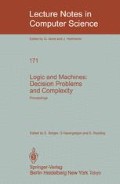Abstract
In MENZEL & SPERSCHNEIDER "R.e. extensions of R1 by finite functions" families of partial recursive functions of the sort R1 UF were investigated, where R1 is the set of all total recursive functions from N to N and F is a subfamily of Fin which is the set of all partial functions from N to N having a finite initial segment of N as domain. Here we treat families F which are defined by some "length-set" in the following sense: for a function δ∈Fin define lg(δ to be the cardinality of the domain of δ (read "lg(δ)" as "the length of δ"), and for L⊑P define Fin(L):={δ∈Fin|1g(δ)∈L}. The length-problem is then stated as the following problem:
(LP) Characterize the sets L⊑P such that R1∪Fin(L) is r.e.. If R1∪Fin(L) is r.e., then L is in the level Σ2 of the arithmetical hierarchy. Conversely, for a set L in Σ1, (LP) is trivially solved in that R1∪Fin(L) is r.e. iff L is infinite. Sets L in Π1 are more difficult to treat. Let L be r.e. with infinite complement. If L is not hyper-simple then R1∪Fin(LC) is r.e.. This is shown by providing for each partial recursive function ϕe a "follower" ψe which is equal to ϕe in case ϕe∈R1 and is an element of Fin(LC) otherwise. Providing such a "follower" ψe for ϕe is constructive (we need only one follower for each ϕe which is never "given up") and extensional (ψe depends only on ϕe and not on e). Enumeration of ψe is uniform in e, hence {ψe|e∈N} is a r.e. family between R1 and R1∪Fin(LC). Since for arbitrary r.e. set L we show that Fin(LC) is r.e. it follows that R1∪Fin(LC) is r.e. as the union of the two r.e. families {ψe|e∈N} and Fin(LC).
We prove that such a constructive and extensional way of providing a follower for each partial recursive function under the condition that the resulting finite functions have a length in LC can be applied only to non-hyper-simple sets L. By more sophisticated methods we show that there is even a maximal set M such that R1υFin(MC) is r.e..
A subfamily F of Pn is called recursively enumerable (r.e.) iff there is a r.e. subset B of N such that F={ϕ (n)b |∈B}; B is called a basis for F.
For a subfamily F of Fin we additionally call F canonically enumerable (or canonically decidable) iff {n|δn∈F} is r.e. (or decidable).
Preview
Unable to display preview. Download preview PDF.
Abbreviations
- N:
-
set of all natural numbers, including 0
- f(x)↓:
-
f is defined at x
- f(x)↑:
-
f is undefined at x
- dom(f):
-
{x|f(x)↓}, the domain of f
- rg(f):
-
{f(x)|x∈dom(f)}, the range of f
- f⊑g:
-
g is an extension of f
- fГA:
-
the restriction of f to A
- Pn :
-
the partial recursive functions from NN to N
- Rn :
-
the total recursive functions from NN to N
- Fin:
-
{δ∈P1|dom(δ) is a finite initial segment of N}
- lg(δ)=1:
-
iff dom(δ)={0,...,l−1} (the length of δ)
- ϕ (n)e :
-
the function in Pn computed by Turing-machine e
- ϕe :
-
ϕ (1)e
- ϕe,s(x)=y:
-
iff Turing-machine e with input x stops within s steps with output y and e<s, x<s, y<s.
- We :
-
dom(ϕe)
- We,s :
-
dom(ϕe,s)
- (Dn)n∈N :
-
is the usual canonical numbering (coding) of all finite subsets of N
- (δn)n∈N :
-
is some fixed canonical numbering of Fin
Literature
MENZEL, W. & SPERSCHNEIDER, V., Recursively enumerable extensions of R1 by finite functions, in this lecture notes volume
ROGERS, H. Jr., Theory of recursive functions and effective computability, McGraw Hill, New York
Author information
Authors and Affiliations
Editor information
Rights and permissions
Copyright information
© 1984 Springer-Verlag Berlin Heidelberg
About this paper
Cite this paper
Sperschneider, V. (1984). The length-problem. In: Börger, E., Hasenjaeger, G., Rödding, D. (eds) Logic and Machines: Decision Problems and Complexity. LaM 1983. Lecture Notes in Computer Science, vol 171. Springer, Berlin, Heidelberg. https://doi.org/10.1007/3-540-13331-3_35
Download citation
DOI: https://doi.org/10.1007/3-540-13331-3_35
Published:
Publisher Name: Springer, Berlin, Heidelberg
Print ISBN: 978-3-540-13331-5
Online ISBN: 978-3-540-38856-2
eBook Packages: Springer Book Archive

